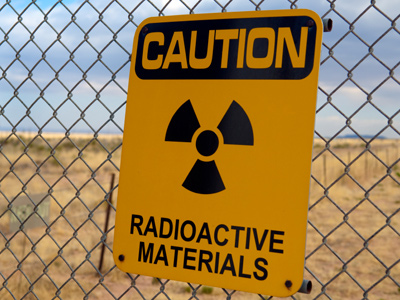This GCSE Physics quiz on radioactivity takes a look at radioactive substances. Radioactive substances emit hazardous particles which can damage the structure of materials and molecules including those in our own bodies. It is released as the nucleus of an unstable atom decays, breaking down into new materials. It only happens to unstable isotopes of element, for example, carbon-12 atoms are stable isotopes and their nuclei never change. Carbon-14 is an unstable isotope and sooner or later, its nucleus will change to a nitrogen-14 nucleus by emitting radiation. Radioactive decay is spontaneous, in other words, it happens at random and for no apparent reason.
As time progresses, the level of radioactivity emitted from a sample will drop as the nuclei of the atoms break down into new, more stable isotopes.
This is measured by the half-life. The half-life is the time taken for the level of radioactivity to drop to half of its original level. The shorter the half life, the more rapidly radioactivity levels will decrease to a safe level. The half life can be followed using a Geiger-Muller tube. Readings of the radiation level are taken at set intervals and can be plotted on a graph. You can then find the time it takes for the level to decrease by one-half from the curve of best fit. The half life of carbon-14 is 5,730 years. In other words, if you started with a sample of carbon that contained 1g of carbon-14 atoms, after 5,730 years, there would be 0.5g left.
Radioactivity can cause a wide range of health issues including cancer and mutations in unborn animals, including humans. Following the dropping of the atomic bomb on the Japanese cities of Hiroshima and Nagasaki, people who were not killed in the blast suffered terrible burns and radiation sickness. One of the first signs of radiation sickness is vomiting, which can start within a few minutes of receiving a deadly dose. Later, other symptoms appear like headaches, hair falling out and diarrhoea. It is therefore important for people handling radioactive materials to use the proper equipment and wear protective clothing to keep them safe.
On the other hand, radioactive materials can be very useful. Radioactive tracers are short half-life isotopes of radioactive elements that are injected into the body so that doctors can find out what needs to be done to treat a patient. Radioactive isotopes can also be used to treat some types of cancer. In industry, radioactive isotopes are used to control the thickness of materials such as paper.
There are three types of radiation - alpha, beta and gamma. Alpha radiation is made up from helium nuclei (two protons and two neutrons). Since these are relatively large, they can be easily stopped by paper, cloth and a few centimetres of air. They are the most dangerous to humans when inside the body as they have no chance of passing through body cells without being absorbed. Beta particles are fast-moving electrons, these can't be stopped using paper or cloth, it requires a thin sheet of metal to absorb them. Inside the body, they are still dangerous but it is possible that some of the beta particles could pass through body cells and escape from the body. Gamma is the highest energy type of radiation, it is an electromagnetic wave and therefore travels at the speed of light. It takes several cm of lead or several metres of concrete to stop it. It is the least harmful inside the body as most of it will pass straight through the cells and out of the body.








